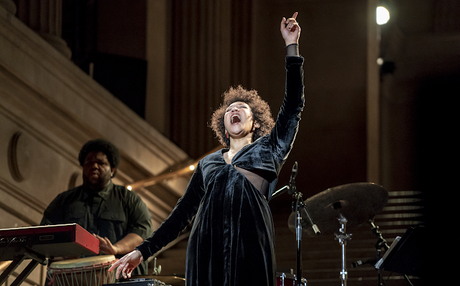by Paul J. Pelkonen

Julia Bullock (center) and composer-percussionist Tyshawn Sorey recreate the world of Joséphine Baker in Perle Noir
at the Metropolitan Museum of Art. Photo by Stephanie Berger © 2019 Metropolitan Museum of Art.
Halfway up this staircase on its landing sat the work's composer. Mr. Sorey manned an array of heavy percussion instruments and an electronic keyboard simulating a piano. At the bottom (right next to the audience) were placed members of the International Contemporary Ensemble, on strings, saxes and brass instruments. The entire staircase was Ms. Bullock's, her stage, her dance floor and her platform for these deconstructions of songss made by the legendary African-American singer, dancer and film star Joséphine Baker.
Ms. Baker remains an icon into this century. She is remembered for scintillating films, smoky torch songs and her refusal to perform for segregated American audiences. She rose to fame in 1927 performing in the Folies Bergère, clad only in a skirt made from artificial bananas. She married a French industrialist in 1937 (the third of four husbands) and continued to sing on the Parisian stage and act in movies. She was an agent of the French Resistance in the Second World War. In 1963, she returned to America to speak beside Martin Luther King Jr. in the March on Washington.
In this work, Mr. Storey uses sophisticated techniques to alter the songs that Ms. Baker made famous. The songs were slowed, stretched, chopped and screwed, becoming sharp probes into questions of identity and the perceptions of a world that, as today, is blinded by the poison of racism. Each was powerfully delivered, often from a different point on the vast staircase by Ms. Bullock, an elegant and uncompromising figure in black velvet. With her steely presence and rich, dark soprano, she was an effective reincarnation of the famous singer, turning each of the eight songs on the program into an intense crie de couer.
The songs were accompanied by surging washes of brass and wind from the I.C.E. players. Mr. Storey proved a versatile musician, switching from piano to sitdown drum kit, occasionally standing up to punctuate the music with a roll of timpani, a wash of gong or the terrifying thud of a bass drum, recalling Mahler's use of the same instrument in the Symphony No. 10. In another song he picked up a djembe and the tempo too, allowing Ms. Bullock to sing over a shifting, hypnotic beat.
Toward the end of the evening, Ms. Bullock kicked off her shoes and stripped off her top, revealing nothing but mesh underneath. The hall fell silent as she danced, barefoot down the stairs, recreating Ms. Baker's legendary moves with a snap of wrist and jab of elbow. On and on she danced, her feet silent on the stairs into the uncompromising glare of a floor-mounted spotlight that shone up the stairs, throwing shadows. And then the silent reverie was nearly destroyed by an ill-timed and persistent cell phone from somewhere in the audience. However, she's a professional.
The show ended with a hybridization of the spiritual "Terre Sèche" ("Dry Earth") with "My Father How Long." It became a shriek of rage against the injustice and racism of American society. Mr. Storey's technique stretched the music and the singer to their absolute limits, recreating these songs as a powerful and contemporary statement. It may not have been what the $125 a seat audience, perched in the dark in their uncomfortable wooden folding chairs wanted to hear, but it was certainly a message worth delivering.
If you enjoyed this article, it's time to click over to Superconductor's Patreon page, and help support the cost of independent music journalism in New York City at the low cost of just $5/month.

